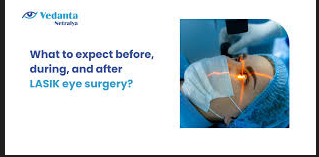LASIK eye surgery offers a solution for those looking to correct their vision and reduce dependence on glasses or contact lenses. Understanding what to expect before, during, and after the surgery can help alleviate any anxiety and ensure a smooth experience. From the initial consultation to the recovery process, each stage of LASIK surgery is designed to provide optimal results and patient comfort. Knowing the steps involved can help you prepare mentally and physically for the procedure. This guide will walk you through the LASIK journey, offering insights into each phase.
Before LASIK Surgery
Before undergoing LASIK surgery, you will have a comprehensive eye examination to determine if you are a suitable candidate for the procedure. This evaluation includes measuring your eye’s shape, corneal thickness, and refractive errors, as well as checking for any underlying eye conditions. It is crucial to provide your complete medical history and inform your surgeon of any medications you are taking. This helps ensure the procedure is safe and effective for your specific situation. In the days leading up to the surgery, you may be advised to stop wearing contact lenses, as they can alter the shape of your cornea. Your surgeon will provide specific instructions on how to prepare, including any restrictions on eating or drinking before the procedure. Follow these guidelines closely to ensure the best possible outcome. Being well-prepared and understanding what to expect can help reduce anxiety and set the stage for successful LASIK surgery.
During LASIK Surgery
On the day of your LASIK eye surgery in Wilmington NC or a city near you, you will arrive at the clinic and be prepped for the procedure. LASIK is typically performed on an outpatient basis, and the entire process usually takes about 30 minutes for both eyes. Before the surgery begins, numbing eye drops will be applied to your eyes to prevent any discomfort. You may also be given a mild sedative to help you relax. Once you are comfortable, the surgeon will use a special instrument to keep your eyelids open and ensure that your eyes remain still. The actual procedure involves creating a thin flap in the cornea using either a microkeratome blade or a femtosecond laser. The surgeon will then lift this flap and reshape the underlying corneal tissue using an excimer laser. This laser removes tiny amounts of tissue with precision to correct your vision. You will be asked to focus on a target light during the procedure, which helps keep your eyes steady. The laser reshaping usually takes only a few minutes, and then the corneal flap is repositioned. The flap adheres naturally without the need for stitches. Most patients experience little to no discomfort during the surgery, and the procedure is remarkably quick.
After LASIK Surgery
Immediately after the surgery, you may experience some mild discomfort, such as a gritty sensation in your eyes, tearing, or sensitivity to light. These symptoms are normal and typically subside within a few hours to a couple of days. Your surgeon will provide protective shields to wear over your eyes to prevent you from accidentally rubbing them and to protect them while you sleep. Follow all post-operative care instructions carefully to ensure proper healing. You will need someone to drive you home after the procedure, as your vision may be blurry initially. Most patients notice a significant improvement in their vision within the first 24 hours. However, it is essential to attend all follow-up appointments with your surgeon to monitor your healing progress and address any concerns. During the recovery period, avoid strenuous activities, swimming, and exposing your eyes to dust or smoke.
Long-Term Care and Results
The majority of LASIK patients achieve 20/20 vision or better, but individual results can vary. It is important to have realistic expectations and understand that some patients may still need to wear glasses or contact lenses for certain activities, such as reading or driving at night. Your vision may continue to stabilize over the first few months following surgery. Regular eye exams are essential to monitor your eye health and maintain your vision correction. In the long term, LASIK offers a permanent solution for many vision problems, but it does not prevent age-related changes to the eyes. Conditions such as presbyopia or cataracts may still develop later in life, potentially requiring additional treatment. Staying informed about your eye health and maintaining regular check-ups will help you enjoy the benefits of LASIK for many years.
Potential Risks and Considerations
While LASIK is a safe and effective procedure for most patients, it is important to be aware of potential risks and complications. Some patients may experience dry eyes, glare, halos, or difficulty with night vision following the surgery. These side effects are usually temporary and improve over time, but in some cases, they can be persistent. It is crucial to discuss any concerns with your surgeon and understand the likelihood of these risks based on your circumstances. Choosing an experienced and reputable surgeon can significantly reduce the risk of complications. Thoroughly research potential surgeons and clinics, read reviews, and ask for recommendations from trusted sources. During your consultation, ask about the surgeon’s experience, success rates, and any additional information that can help you feel confident in your decision.
LASIK eye surgery can significantly improve your vision and quality of life. By understanding what to expect before, during, and after the surgery, you can approach the process with confidence. Preparation and adherence to your surgeon’s instructions are key to a successful outcome. Post-operative care and long-term eye health are equally important in maintaining the benefits of LASIK. Although there are potential risks, being well-informed and choosing a skilled surgeon can greatly reduce these concerns. LASIK offers a promising solution for many individuals seeking clear vision without the reliance on glasses or contact lenses.



